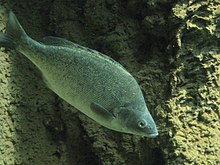Bidyanus bidyanus
| Bidyanus bidyanus | ||||||||||||
|---|---|---|---|---|---|---|---|---|---|---|---|---|

Bidyanus bidyanus |
||||||||||||
| Systematics | ||||||||||||
|
||||||||||||
| Scientific name | ||||||||||||
| Bidyanus bidyanus | ||||||||||||
| ( Mitchell , 1838) |
Bidyanus bidyanus (English Silver Perch or Bidyan ) is an Australian freshwater fish and the largest member of the group of groupers (Terapontidae). It is fished in Australia and is a popular food fish that is also grown on aquaculture farms.
features
This Australian grouper grows up to 40 centimeters long and 8 kilograms in weight (less than 30 centimeters and 1.5 kilograms are typical). The head is relatively small, the mouth beak-like. The body is silvery-gray, also olive green or brown, with darker scales. The scales are relatively small. The belly is whitish, the fins grayish or blackish in color. Young fish are similarly colored but with dark spots on their backs.
- Fin formula : dorsal XII – XIII / 11–13, anals III / 7–9, pectorals 16–17.
- Scale formula : SL 55–62.
Occurrence and habitat
Bidyanus bidyanus was originally distributed throughout the Murray Darling Basin , with the exception of the upper reaches. Now the species is rare, but has since been introduced to many other rivers outside of its natural range in southeast Queensland, New South Wales and southwest Western Australia.
The fish live in rivers and artificial water basins and prefer places there with fast currents, e.g. B. at weirs or rapids. They swim in groups near the surface in open water. They tolerate temperatures from 2 to 37 ° C.
Way of life
This species of grouper feeds on insects, mollusks, annelids and algae. Spawning time is during the Australian summer floods from November to January, when water temperatures rise above 23 ° C. The fish then migrate far into the upper reaches of the rivers to spawn. Due to the numerous obstacles in the form of dams and weirs, these migrations are prevented today, which is a cause of the threat to the species. The females release numerous eggs that float in the water. The larvae hatch after about 30 hours. The juvenile fish reach sexual maturity after two to three years.
literature
- G. Allen, S. Midgley, M. Allen: Field Guide to the Freshwater Fishes of Australia . 2nd Edition. Western Australian Museum, Perth 2003, ISBN 0-7307-5486-3 , pp. 215, 217 .
Web links
- Bidyanus bidyanus on Fishbase.org (English)
- Bidyanus bidyanus inthe IUCN Red List of Threatened Species 2015.4. Listed by: Wager, R, 1996. Retrieved November 21, 2015.
